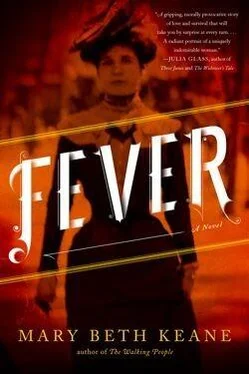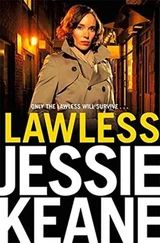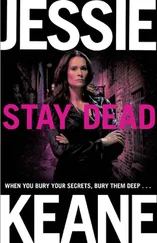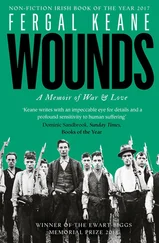How had he figured it out? Everyone wanted to know. And, oh, how he loved to tell the story. Mary imagined him perfecting that calm remove in front of a mirror at home. How? It was simple. One merely had to be brilliant and determined. She wanted to point out that the story had been in all the newspapers — surely everyone sitting in the room already knew it — but no, they would give the doctor a platform, and they’d all have to sit through it again. She felt her stomach clench as he sat back in the chair and crossed one leg over the other. Mary closed her eyes, counted to ten.
“Dr. Soper,” the other lawyer said after listing Soper’s credentials, “please explain to us the events leading up to your investigation in Oyster Bay, and your conclusion that Mary Mallon was at the root of the outbreak that struck the Warren family in the summer of 1906.”
Soper relaxed further, placed his hands neatly atop his knees. He was so well rehearsed that Mary wondered if he even had to pay attention to what he was saying.
“I was busy with the subway sanitation problems, but there was something about this case that pushed me on the train to Oyster Bay to have a look. I got there in the second week of January 1907, and I’ll admit that I was no more clever than the other investigators Mr. Thompson hired, at first. Like them, I initially thought the family might have gotten Typhoid after eating soft-shell crabs, and then I thought perhaps it was the water. I dropped blue dye in the commode and then waited to see if the drinking water ran blue. It didn’t. I swabbed the tank but found no typhus bacilli. I stayed for three days and interviewed shopkeepers in town, a police officer, the postman who delivered mail to the Warrens the previous summer. Except for a governess and a music teacher the Warrens had brought with them from Manhattan, they’d hired all local staff, and I went to their homes and asked them to recall everything they could from the week the illness broke out, who among the household had gotten sick and when. Finally, the stable hand, a man named Jack, mentioned in passing at the conclusion of our interview that he didn’t think any of the sick would have made it if it hadn’t been for Mary. I double-checked the notes the other inspectors had forwarded to me, but none mentioned a servant named Mary. The only cook on my list was a woman named Bernadette Doyle. When I pressed Jack, he said that Mrs. Doyle left at the end of July. Her daughter was expecting a baby that came early. So the Warrens sent for another cook. Mary got there on the third day of August.
“I was calm as I made a note, and then checked it against the first sign of fever: August eighteenth. You can imagine how exciting this was.”
The lawyer nodded that he could imagine, and glanced toward the judges.
“I wanted to make absolutely certain,” Soper continued. “ ‘Are you sure about the date?’ I asked Jack.
“ ‘Sure I’m sure,’ Jack said. ‘The day she came was my birthday. She made the best peach ice cream I’ve ever had, and she was nice to look at.’ These were Jack’s words, you understand. He told me that this cook named Mary stayed on to look after everyone who had come down with the fever. Not until they had all recovered did Mary return home. At that point it was mid-September.
“After that,” Soper said, “it was so simple, a child could have figured it out.” He described returning to Manhattan and contacting the agency the Warrens had used to find Mary. He had them send a list of all the other families Mary cooked for through the agency, in addition to the residence where she was currently employed.
“One by one the families got back to me reporting Typhoid outbreaks within a few weeks of Mary’s arrival. I assembled the data, and one afternoon in late February, I went over to the Bowen residence and rang the bell. I was willing at that point to believe it wasn’t her fault — as you know, there are still many doctors who cannot accept the theory of a healthy carrier — and I was prepared to explain it to her. I had not expected to be spoken to so rudely and threatened with a knife. I left a note for Mr. Bowen, but when I passed again several days later, I was shocked to see Mary’s head disappear into the servants’ entrance.”
“And what have you since learned about that note?”
“That the Bowens never received it.”
Mary could still see the flick of Frank’s wrist as he threw the note into the flames. The Bowens had fired him several weeks after Mary’s capture, and she hadn’t heard anything about him since. Fired for helping her, she considered once again and felt the guilt of that press up against her. Fired for knowing her. For being her friend.
“When did you next attempt to speak to Miss Mallon?” the lawyer asked.
“A week or so later, at the building where she lives on Thirty-Third Street.” Mary noticed that the courtroom seemed to darken around the edges of her vision, and she felt herself pull away. She felt all over again the shock of arriving home after a week’s work, just getting settled, hearing the knock on the door, and seeing Alfred open it to find Dr. Soper. “It’s very important that I speak with you,” he’d said, ignoring Alfred entirely and taking a slight step forward as if he’d been invited inside.
She sipped from the glass of water Mr. O’Neill nudged toward her.
“And?” the lawyer pushed.
Dr. Soper glanced in her direction so quickly that Mary wondered if she had imagined it. He smoothed the lapel of his jacket.
“And I was unsuccessful. Neither she nor her companion would listen. It’s possible that the first time I met Miss Mallon I was too abrupt, too scientific about the problem. I’ll grant that. I had a sense of urgency when I went to see her at the Bowen residence, and perhaps I didn’t consider her feelings. When I visited her at her own rooms, I tried a different tack. When she saw it was me at her door, she shouted, ‘What do you want with me?’ So I asked her very calmly, ‘Haven’t you noticed that disease and death follow you wherever you go?’ ”
He was telling the truth about what he’d said, but Mary remembered his tone, and it wasn’t calm. It was an accusation. Still standing at the door, Alfred had looked back and forth between them, and then stepped away. She remembered shouting, but not what she’d said. She remembered that he seemed to grow more calm as she got more upset.
“And what was her response?”
“Anger, as far as I could tell. Once again, she came after me with a knife.”
A knife with a blade so dull it could barely cut butter, Mary thought. She’d wanted to argue with him that day, but she couldn’t make sense of what he was saying, couldn’t get past the jolt of seeing him again. Disease and death didn’t follow her any more than they followed anyone else. People had been dying her whole life. First her father, in a fire. Then her mother, of a cough. Then, a few years later, her brother, then her other brother, then her sister in childbirth, then her sister’s two babies, and then her beloved nana while Mary was en route to America. Had they had fevers? She supposed they had, but she couldn’t remember, and anyway, those sicknesses that kill a person always come with fever, and in Ireland they didn’t name their fevers. People became sick. They died. She never heard the word Typhoid until she came to America.
“Was this the first time you learned that she had a companion?” The attorney checked his notes. “Mr. Alfred Briehof?”
“Yes.”
“And what can you tell us about that?”
“When I first arrived at the address the agency had provided to me, I saw Mary outside on the stoop, presumably having just arrived home. I was about to announce myself, but a man approached and embraced her. On the street. I assumed she was engaged to be married, but I’ve since discovered that she is not. It was Mr. Briehof who answered my knock when I tried to speak to her at the door to their rooms not ten minutes later.”
Читать дальше












